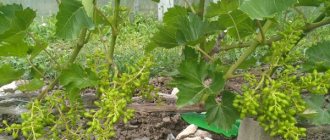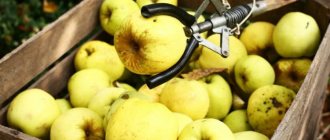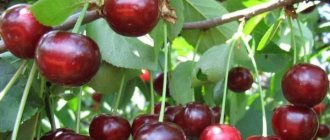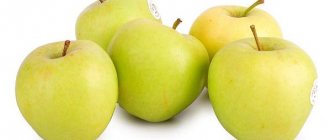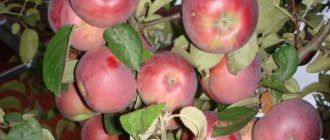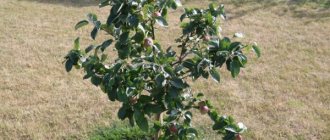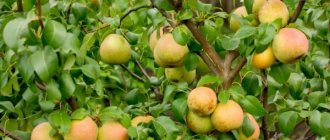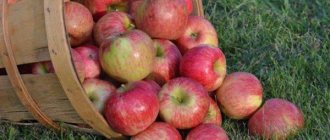The right choice of apple tree variety in combination with the necessary agricultural technology will allow you to get a decent and tasty harvest. Gardeners choose the dwarf variety of the frost-resistant Chudnoe apple tree, photos, reviews and descriptions of the variety below, for its unpretentiousness, juiciness of fruits and ease of harvesting. The tree is not afraid of close proximity to groundwater and can withstand cold winters. The fruits are formed 3 years after planting the seedling. An adult tree produces up to 20-25 kg of apples per season.
History of selection
The apple tree variety was bred by Russian scientists from the Chelyabinsk Research Institute of Horticulture and Potato Growing. The Ural breeder M.A. Mazunin worked on the creation of a dwarf tree. He crossed two worthy varieties - the German Elisa Rathke and the Russian Ural Winter (northern). Mikhail Alexandrovich developed a whole series of apple trees, which received the popular name Mazuninsky dwarfs. Wonderful has the amazing taste of German apples and the high frost resistance of domestic Ural apples. The variety is suitable for cultivation in any climatic zone of the Russian Federation. It is a natural dwarf but can also be grafted onto a vigorous rootstock.
Origin and zoning
Since the 1930s, in the nurseries of the Chelyabinsk fruit and vegetable station, domestic scientists have conducted research aimed at creating winter-hardy apple varieties suitable for cultivation in the Urals and Siberia. “Wonderful” was created by the outstanding breeder M.A. Mazunin as a result of crossing a complex hybrid (“Uralskoye Zimnee”x11-20-12) with the ancient German variety “Eliza Rathke,” better known as “Vydubetskaya weeping” - a carrier of the stunting gene. The resulting apple tree is capable of producing high yields of high-quality fruits in short, cool summers, and its dwarf size and crown, which bends low to the ground and practically creeps along it, provide the plant with the ability to withstand winter frosts and winds.
Apple tree "Wonderful" is low-growing, with a creeping crown, the shoots have an arched shape, bending to the ground
According to the State Register of the Russian Federation, “Wonderful” is recommended for cultivation in the Ural and East Siberian regions. But in fact, the variety is distributed throughout almost the entire territory of Siberia, the Urals, the Far East and North-West of Russia, where in the summer there is enough warmth for growth and fruiting, and in the winter there is a lot of snow to protect it from freezing.
Description
Dwarf apple trees have their own characteristics that distinguish them from ordinary varieties. One of them is simplified agricultural cultivation technology. The variety of low-growing tree was focused on the weather conditions of the Ural region, the chemical composition of the soil, and the level of groundwater. Besides this, the low size of the Wonderful makes it easy to care for the apple tree. Photo of an apple tree of the Wonderful variety:
The yield of the variety is easy to maintain by following the growing rules
Appearance of fruit and tree
Natural dwarfs are always short. Variety parameters:
- The height of the Chudnoe apple tree does not exceed 1.5 m. If the variety is grafted onto a vigorous rootstock, then the adult tree reaches a height of 2.0-2.5 m. The Chudnoe apple tree is a naturally low-growing tree. Its crown is voluminous, about 3 m wide, the branches are spread to the sides. When the time comes for the harvest to ripen, they fall down to the ground under the weight of the fruit. If pruning is not practiced when caring for a tree, the crown becomes very dense. At the same time, it almost spreads along the ground. Annual growth is about 10 cm.
- The trunk diameter is small. In a tree on a natural scion it is 8-12 cm, on a dwarf scion – no more than 10 cm.
- The root system of the dwarf tree is fibrous, strong, located in the fertile layer, with a good growth rate.
Occupies quite a large area. This allows the Chudnoye variety to withstand wind gusts well and not react to the shallow depth of groundwater. Important! The dwarf variety lacks a main root. - The leaves of the Chudnoye apple tree are oval-shaped, medium-sized (up to 7 cm), rich green in color. The surface of the plates is glossy, there are small light stripes on it.
- The fruits of the dwarf variety are large, the weight of one apple is 120-140 g. Under good growing conditions and upon reaching maturity, it can be 200 g. The shape of the fruits is flat-round, some have slight ribbing, the funnel is weakly expressed. The variety inherited the appearance of apples from the German Eliza Rathke. The main color is yellowish-green. The top coat color may be completely absent or appear as an uneven dark red blush. Usually it is located on the side of sunlight and signals the ripeness of the fruits of the Wonderful apple tree. The skin is thin, with small dots visible underneath. The pulp is juicy, but dense, crunches when eating the fruit.
Lifespan
Depending on the climatic conditions of the region, the lifespan of the Chudnoye variety varies. The maximum period during which a tree is viable is:
- Central zone - from 40 years to 45 years;
- Siberia and the Urals - no more than 35 years;
- areas of temperate climate up to 40 years.
A dwarf tree survives to the specified maximum levels only with high-quality care and timely rejuvenation.
Taste
The fruits of the Chudnoe variety have tight, dense pulp and a granular structure. Ripe apples have a dessert taste, sweet with a slight sourness. Tasting score 4.6 points. The main value is due to the balanced composition of the fruit. Apple fruits contain up to 11% sugars, 14% dry substances, 1.2% pectin compounds. Apples are high in vitamin C – up to 20 mg. When consumed fresh, the entire spectrum of beneficial elements enters the human body. Some housewives prepare compotes, preserves, marmalade, other desserts and even aromatic wine from the fruits.
Important! Juices, compotes and other preparations do not require added sugar.
The photo shows the Chudnoye apple variety:
The appearance of the fruit emphasizes its amazing taste
Growing regions
The variety is zoned for the Ural region. In the regions, it is necessary to cover young trees with spruce branches before the onset of winter, after mulching the soil.
Also, the weather in the Moscow region is very favorable for growing the dwarf Chudnoe apple tree. Gardeners only need to water the tree in a timely manner during drought periods. Special agrotechnical measures are not needed, crown formation and fertilizing are also not needed.
When planting a variety in Siberia, it is necessary to insulate not only the tree trunk, but also the trunk of the tree. Although the apple tree can withstand low temperatures well, such measures will still have to be taken.
Important! If the winter is snowy, you can cover the young trees to the top with snow.
In North-West Russia, the variety demonstrates excellent productivity and responds well to fertilizing. It is mandatory to carry out preventive treatments against fungal infections. Best in early spring and twice.
Productivity
The main indicators of the yield of a dwarf tree are constancy (annuality), independence from climatic conditions. One tree produces up to 85 kg of delicious fruit. The maximum yield value shows in 5-7 years. The indicator drops with strong crown thickening and moisture deficiency. Increases when planting pollinators in the garden. The variety has excellent keeping quality, which is not typical for late-summer varieties. The shelf life reaches 1 month with full preservation of taste and commercial qualities.
One tree produces a surprisingly large number of apples.
Frost resistance
Despite its small size, the Chudnoye apple tree can withstand even severe frosts. The plant is not afraid of temperatures dropping to -40 °C. A very valuable quality of the dwarf variety is its ability to withstand spring frosts, strong winds and temperature changes in extreme continental or continental climates. However, breeders recommend covering trees in areas with prolonged frosts and snowless winters. During periods without snow, it is important to additionally cover the lower part of the trunk.
Resistance to diseases and pests
The description notes the resistance of the apple tree to fungal infections. The variety resists scab, bacteriosis, powdery mildew, and fruit rot well. Parasites - scale insects, bark beetles, and aphids - cause more harm to the tree. To prevent the spread of pests, it is necessary to treat the apple tree with copper-containing preparations or urea. It is imperative to collect and remove fallen leaves or debris, and dig up the tree trunk circle in the fall. It is also important to inspect the bark and leaves regularly.
Flowering period and ripening period
The apple tree of the Chudnoe variety bears fruit from the 3rd year of life. Flowering begins in the 2nd year.
Important! It is recommended to remove the first flowers so that the tree does not waste unnecessary energy.
In this case, all forces will be directed to the growth and development of the seedling.
The flowering period is extended, beginning at the end of April or beginning of May. The exact time depends on weather conditions. The flowering of the Wonderful variety has its own characteristics. At first, the flowers cover the upper branches. This allows the tree to calmly survive return frosts. The fruit ripens in late summer, apples are ready for harvest in August.
You should carefully select the planting site in order to use the decorative effect of the variety at the time of flowering.
Pollinators
The Chudnoye variety does not require pollinators to form a harvest. But, in this case, only part of the flowers will be pollinated. To get the maximum number of ovaries, you need the help of other types of apple trees. The best pollinators for the Chudnoye apple tree are the Ural dwarf varieties Bratchud, Prizemlennoye, and Anis Sverdlovsky.
Transportation and keeping quality
When dropped, apples of the Chudnoye variety are almost not injured and are not subject to rotting. Therefore, the crop tolerates transportation well over long distances. At the same time, the quality and presentation of the fruit remains the same. The author of the selection included another unique property for the late-summer apple variety - good keeping quality. They can even be stored in a room for a month. Under favorable conditions in the refrigerator or cellar, they retain their quality until October.
Reviews from gardeners
Sergey, 48 years old, Krasnoyarsk
Wonderful is simply an amazing miracle! The apple tree is not tall, but it produces a very large harvest, and every year. We don’t remove less than 80 kg from her, although we measured the exact amount only once. Even with spring frosts, the tree bears fruit very abundantly. The thing is that it blooms for a long time, first the flowers appear on the lower branches, and then gradually bloom throughout the tree. Therefore, all ovaries are never damaged.
Andrey, 60 years old, Khabarovsk region
Thanks to the breeders for such a wonderful apple tree. In our climate, she feels great, even winds and frosts are not scary for her. For the winter we cover it with spruce branches and sprinkle it with earth. And how many apples it gives! And how delicious they are! In a word - wonderful!
Ekaterina, 48 years old, Moscow region.
Of course, I read about Chudnoe, that it is recommended to plant it in the Urals or Siberia, but I was captivated by its dwarf shape and the fact that the tree is not afraid of the proximity of groundwater. I planted it on my plot and received a harvest already in the 3rd year. Now the apple tree is already 7 years old and I can’t get enough of it. It looks unusual, it is very convenient to harvest, there is always really a lot of fruit. Enough for food and processing. A real garden decoration.
Advantages and disadvantages of the Chudnoye apple tree variety
Based on the description and reviews of gardeners, the pros and cons of the tree can be grouped. Among the obvious advantages it should be noted:
- precociousness;
- resistance to frost and frost;
- wind resistance;
- ability to grow in close proximity to groundwater;
- efficiency;
- comfort of care due to low height;
- great taste;
- long shelf life.
Apple lovers do not note any significant shortcomings in the variety. The downside is the inability to store the crop longer. This is due to the desire to extend the period of consumption of very tasty fruits.
With proper care, the variety produces an enviable harvest every year.
Disease and pest control
Of all the pests, bark beetles and scale insects are considered the most dangerous for apple trees. They penetrate deep into the cortex, into hard-to-reach places, and it becomes very difficult to remove them from there. Caterpillars and beetles that attack leaves, buds and buds cause no less damage. Aphids cause enormous harm by drinking all the juices from the apple tree.
Description of popular pest control methods:
- The wood is treated with urea (also called urea) or copper sulfate. To get rid of pests that have settled in the bark, the tree is whitewashed twice a year. Sanitary cleaning of the bark reduces the number of insects.
- Insects that attack foliage are collected by hand and burned.
- When fighting the bark beetle, its minks are pierced with wire, and then these places are treated with a syringe with an insecticide.
- To protect the fruits of the apple tree from pests, the tree trunk circle is dug up before winter in order to disturb the insects hibernating in the upper layers. For preventive purposes, fallen leaves are collected and burned.
- Debris or rotting leaves under a tree are an undesirable phenomenon, so periodic cleaning is necessary, and insects will not have time to take root on the apple tree.
Prevention will save your time and nerves that are wasted when dealing with pests. Spray apple trees with copper sulfate, iron sulfate or Bordeaux mixture, whiten the tree bark and clean it, check the crown of the apple tree for pest nests.
Planting a Chudnoe apple tree
Its further growth and development depends on the quality of planting of the seedling. There are certain rules that must be followed. This will allow you to grow an amazing apple tree on the plot on a dwarf rootstock of the Chudnoye variety. You need to pay attention to:
- Term. Optimally - early autumn (no later than mid-October) and spring (until mid-April). In the spring, you need to choose a time when the ground has thawed and the buds have not started to grow. In the fall, it is important to finish a month before the ground begins to freeze.
- Place. The Wonderful variety has a unique feature. The tree thrives when groundwater is close to it. Therefore, areas that are completely unsuitable for other fruit trees are suitable for it. The soil is preferably light and nutritious. Sandy loam or loam will do. Pre-lime acidic soil.
Inspect the seedlings before planting. Pay special attention to the condition of the roots. They must be fresh. They need to be planted as quickly as possible, and immediately wrapped in a damp cloth after purchase.
Landing algorithm:
- Prepare planting holes on the site with a depth of 0.5 m and a diameter of 0.7 m. The distance between the holes is at least 3 m.
- Pour 1 bucket of water into each.
- Mix the turf soil with humus and fill part of the hole with the mixture.
- Place the seedling so that the grafting site is 2 cm above ground level.
- Cover the roots with soil, trample them a little, and water them generously.
- Form a roller of soil for subsequent watering.
Seedlings should be placed at a sufficient distance so that they develop well
Features of growing Wonderful
Apple trees of this variety do not have any special requirements for cultivation; they are hardy and unpretentious, so following the general rules will be enough to grow them.
Landing
Basic conditions
- Trees do not have any special requirements for the planting site. However, it is better if it is a fairly sunny area, even if it is in a draft, apple trees are not afraid of this at all.
- The height of the groundwater does not affect the rhizome in any way, so you can ignore this factor and even plant Wonderful near open reservoirs.
- The root system is small, so it is enough to dig holes for planting 50 centimeters in depth and the same in diameter.
- It is advisable to prepare the holes in advance (2-4 weeks or in the fall), filling them with soil mixed with humus, river sand and other substances. They are filled with 20-40 liters of water and left in the open air.
- The root collar should be approximately 2-3 centimeters above the soil surface. If you deepen it, it will not spoil the quality of apples and future yields, but growth and development may slow down noticeably.
- A bucket of water is poured into the bottom of the hole immediately before planting, then the seedling is placed there, its roots straightened, sprinkled with soil, shaking slightly so that there are no air pockets left, and lightly compacted. Another 10-20 liters of water are poured on top, the surface is mulched with humus or manure, chopped grass.
When purchasing seedlings of the Chudnoe variety, you should not be surprised if they are very small and seem fragile and flimsy. High-quality planting material barely reaches a height of 15 centimeters and can have a root system 10-15 centimeters in diameter. The main thing is to make purchases from trusted sellers, preferably in nurseries that provide comprehensive documented information about their product.
Disembarkation dates
The variety is planted at the same time as the bulk of all other apple trees. In spring, this is most often April, when the soil has already completely thawed and there is no risk of frost. In the autumn, this can be done at the end of September or beginning of October after the leaves have fallen, but leaving another 2-4 weeks of reserve before frost.
The second option is considered more preferable by experienced gardeners. It gives the apple tree more time to adapt to its environment, especially when it comes to open rhizomes.
Protection from frost and rodents
Even young trees require protection from low temperatures only in exceptional cases, for example, in the Far East or Siberia, where winter temperatures can drop below the anomalous -47°C. But even here there will be little work - just shovel snow on the tree and it will not be afraid of any cold. Many people prefer to cover young seedlings with spruce branches or straw; this won’t hurt, of course, but it doesn’t make much sense either.
Coating the trunks with grease or rendered lard helps prevent rodents. To repel insects, you have to regularly whitewash trees with lime. You can also purchase various industrial production products, which are affordable and sold in gardening stores.
Tree care
Loosening the soil, watering: proper agricultural technology
Pulling out weeds, eliminating root growth, shoots of bushes and trees, as well as regularly loosening the soil are standard procedures carried out by all gardeners. It won’t hurt to do all this for the Chudnoe variety; it will reward you with good harvests. But even without all this, you can regularly get quite a lot of apples by simply leaving the tree to live its own life.
Apple trees need to be watered only during dry periods, when there is no natural precipitation for a long time. It is good to follow the 10-day rule, in which trees are watered only when precipitation has not fallen during this time. Along with water, you can add fertilizers, which will not interfere, especially during flowering and ripening of fruits.
Pruning: simple crown formation
The first formative pruning should be carried out already in the first year after planting. For example, if you planted a wonderful plant in the spring, then in the fall you will need to reduce the height of the main trunk to 50 centimeters in order for “creeping” side branches to form. When planting in the fall, pruning is done in the spring, before the sap begins to flow.
Next, you will need to regularly remove small excess shoots that thicken the crown, as well as old, diseased or damaged branches. This can be done both in spring and autumn. As the tree ages, you can rejuvenate the tree by removing 2-3 age-old branches and allowing young and strong ones to develop.
Pollinator varieties
- Bratchud.
- Anise Sverdlovsk.
- Down to earth.
Reproduction
- Clones (layers).
- Grafting with cuttings or buds.
- Growing from seeds.
Diseases and pests
- Cytosporosis.
- Leaf roller.
- Flower beetle
- Shield.
Growing and care
Growing the Wonderful variety is very simple. An apple tree does not require special knowledge and skills. The basic rule is proper watering, in other words, regular. In summer you need to water the tree weekly. Consumption per tree – 10 liters.
Loosening after each watering or rain. Care is required to avoid damaging the roots.
Fertilize twice during the season - in spring and autumn. You need to start at 2 or 3 years old. The variety responds well to organic matter (chicken droppings or manure). Dilute the infusion before watering in a ratio of 1:20 (litter) and 1:10 (manure). In the fall, it is good to feed the tree with complex mineral fertilizer with a high content of potassium and phosphorus.
In the first year, be sure to form the lower tier by pruning. Remove the top at a height of 50 cm. In subsequent years, you will need to remove branches growing at an acute angle to the trunk and damaged ones. Even a novice gardener can cope with the formation of a Wonderful apple tree.
Before the onset of winter, be sure to water the apple tree well. In cold regions, mulch the tree trunk, cover the tree with snow, and insulate the lower part of the trunk.
The Wonderful variety will withstand any weather tests only with sufficient watering. The superficial location of the root system requires the gardener's attention to this point of care.
Variants and subtypes
There are several subspecies or varieties of cultivation, which determine the size of the apple tree and the characteristics of its care.
Natural
This is a variety that was created on its own, by random pollination. This subspecies bears fruit later, but is more stable.
Superdwarf
Grafted onto a dwarf rootstock, it bears fruit in the second year. The root system is located close to the soil surface and therefore requires regular watering. The apple tree is even smaller than a dwarf one, maybe a meter tall.
Large-fruited
Apples weighing up to 400 grams, large and plentiful. The tree is a little more capricious and requires regular thinning and fertilizing.
Columnar
The tree does not have a pronounced crown; the fruits seem to be adjacent to the trunk. It looks like a beautiful dense column dotted with fruit.
Down to Earth
The smallest of the subspecies, suitable for growing in regions with short, cold summers. It is also grown as a creeping plant.
Apple tree on superdwarf rootstock.
Collection and storage
The fruits are ready for harvest from mid-August. It is recommended not to delay the procedure so that the fruits do not become overripe. Another reason is that the tree should not waste extra energy on ripe apples. The maximum shelf life of the Chudnoe variety is 4 months. In order for the apples to withstand this time without damage, it is necessary:
- highlight a dark room;
- maintain the temperature no higher than +12 °C;
- humidity indicator no more than 70%.
The ideal place is an enclosed balcony or basement.
Productivity and fruiting
The tree begins to bear fruit 1 year after planting, it is advisable to remove the first flowers, and full harvests can be harvested in 3-4 years.
Flowering begins in different ways, depending on weather conditions. Most often, the apple tree blooms at the end of April - the first days of May.
Flowers bloom first on the lower branches, later on the upper ones. Flowering is quite extended over time.
This allows you to harvest a sufficient harvest, even if there were short-term frosts.
Apples are fully ripened in early or mid-August, depending on current weather conditions.
The fruits have the following characteristics:
- Ball-shaped, slightly flattened shape with slight ribbing.
- The fruits hold well on the stalk and are not prone to falling off.
- The apples are yellow-green, with a faint streaked blush.
The Chudnoe apple tree bears fruit regularly.
The yield is high - up to 80 kg of apples per plant.
The fruits are medium in size, their weight varies from 100 to 200 g.
The fruits have high commercial quality.
General information about culture
The apple tree is one of the main pome crops grown both on private plots and in large industrial gardens of farmers and agricultural organizations. A wild variety of this crop was brought from Asia Minor in the 1st century. BC. to Egypt, Palestine, Ancient Rome as a result of the aggressive campaigns of Alexander the Great.
Thanks to its taste and unpretentiousness, the strange fruit quickly gained great popularity, spreading throughout most countries of Europe and Asia. Over time, through the efforts of breeders, the apple tree turned from a wild species into a cultivated, high-yielding crop. Of the more than 10,000 different varieties bred by scientists, a large group of low-growing apple trees on clonal dwarf rootstocks stands out.
When to collect plantain for medicinal purposes: harvesting rules
Feeding and protection against diseases
For healthy, rapid growth, any plant needs to be fed. Dwarf and semi-dwarf apple trees are no exception. In the second year, fertilizers are applied to the tree:
- compost or rotted manure (norm 30 kg per tree);
- superphosphate (13 g / 1 sq.m);
- urea (19 g / 1 sq.m);
- potassium chloride (15 g / 1 sq.m).
All fertilizers, except nitrogen ones, are included in agricultural practices in the fall, when digging the ground. Urea is divided into two parts: 1/3 is added in mid-summer, 2/3 in mid-spring.
Urea
Description of preventive measures to protect against diseases consists of spraying the foliage a week after flowering. A urea solution is prepared in the proportion of 100 g / 10 l of water.
The species is susceptible to brown rot and bitter pitting. Against them, trees are treated with solutions of calcium chloride or nitrate, 50 - 100 g / 10 l of water.
To protect against other infections and pests, the trunk is coated with a thin layer of lime, oil paint, and garden varnish. If the plant is small, it does not need large volumes of solutions.
Expecting a bountiful harvest, they monitor flowering and prune weak growths. Rationing is being carried out to avoid overloading the apple tree.
Rules for planting and agricultural technology
The Chudnoe apple tree is an unpretentious variety that does not require a lot of time and money. For fast and efficient tree growth, you should follow simple planting rules.
Site selection
Dwarf tree varieties are unpretentious and for the quick and successful cultivation of such plants, fertile soil with a high level of groundwater is required.
Required soil composition
The Chudnoe apple tree grows well in various soils, but loam or sandy loam is better suited. Also, for better growth, the soil must be nutritious. To do this, in turn, various organic fertilizers can be added to the area.
Timing and step-by-step process of planting seedlings
Apple tree seedlings are planted in autumn (September-October) or early spring (March-April). If planting is carried out in the autumn, it is necessary to complete all work within a month before the onset of the first frosts and drops in temperature.
See also
How to grow an apple tree from a branch and how to properly care for the plant
Read
When planting, you need to follow a certain order:
- Before planting the seedling, prepare the soil. To do this, add peat or sand to a pre-dug hole, as well as 10-15 liters of humus. If the amount of acids in the soil is increased, 1-2 kilograms of dolomite flour should be added to the soil.
- Fill the hole with a bucket of slightly warm water.
- When planting, you need to straighten the rhizomes and place them in the hole, cover them with soil on top and compact them.
- Form a special side and hole for further watering of the apple tree.
- The root collar should be above the ground.
- The planting site should be watered with one bucket of warm water.
- If you are planting several trees, you should maintain a distance of 3-4 meters between plants.
Columnar apple trees
How to grow real aloe vera
Columnar apple trees are often confused with dwarf apple trees. These are different concepts. The columnar shape is the opposite of the lush, rounded crown of the usual tree. It is more common in semi-dwarf trees. For small areas, these are beneficial plants that are useful in many respects. Because:
- a wonderful apple takes up little space in the garden;
- convenient for processing;
- decorate the landscape and allow you to experiment with design;
- They bear fruit intensively and early; according to the description, some varieties produce a small harvest already in the first year.
The root system is similar to that of dwarf apple trees, but columnar apple trees are taller. Most of the fruit formations die, moving from bottom to top, because the central shoot takes part in fruiting. At the top point it freezes.
The lifespan of a columnar apple tree is 50 years. However, fruit formation lasts about 10 years. After this, the tree exists only as a decorative one.
